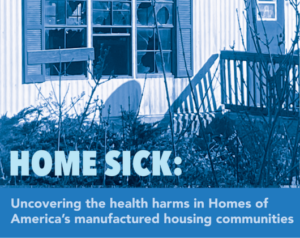In collaboration with Manufactured Housing Action, we explored the state of housing habitability for 10 Homes of America manufactured home communities, and assessed the health impacts of these habitability issues on residents.

They [Homes of America] have made it so miserable for us. We used to love to come home. This was our home. We thought we could live here until we died and our life is so miserable, so miserable. This place has ruined our life, our health, and our future. (Barry Yost, Shadow Wood Mobile Home Park, West Virginia)
Shadow Wood Mobile Home Park, where Barry Yost lives, is one of five manufactured home communities in Mercer County, West Virginia, that Homes of America, LLC purchased as part of its major buy up of manufactured home communities across the Midwest and southern US in recent years. The company, which began its buying spree in 2021, now owns at least 144 manufactured home communities, most of which are in Florida, Michigan, and Illinois.
About 15% of the US population lives in manufactured homes, with nearly 30% of those residents reporting that they are disabled, retired, or unable to work. Traditionally, manufactured home communities — also known as mobile home parks — have provided a vital affordable housing option for people on low or fixed incomes, including the elderly, working class people, immigrant families, and people living with disabilities. Now, large corporate landowners like Homes of America are changing that.
In 2024, Private Equity Stakeholder Project and Manufactured Housing Action published research describing Homes of America’s rent increases and resident displacement through evictions.
Building on this research, we investigated the public health implications of Homes of America’s manufactured home ownership practices, as indicative of broader national trends in corporate ownership of manufactured housing parks and other types of housing.
We draw on in-depth interviews with 20 residents of Homes of America communities in Michigan, Virginia, West Virginia, Illinois, and Florida, as well as an extensive examination of public records obtained through request, including housing code inspections in 10 communities.
Our research found that the unhealthy conditions in the Homes of America communities we examined are linked to serious health impacts.
Key Findings:
- Poor drinking water quality: Several Homes of America communities were found in violation of water quality standards by regulatory agencies. Potential contaminants, like lead and bacteria, may have contributed to residents’ gastrointestinal health and skin issues. All residents we spoke with resorted to buying bottled water to protect their health and described the financial burdens associated with purchasing water and repairing appliances and fixtures damaged by the water supply.
- Water shutoffs: Some communities experienced sporadic water shutoffs lasting hours to days or weeks. The shutoffs left most residents we spoke with without consistent access to water.
- Water and sewage infrastructure failures: Water and sewage main breaks and leaks led to standing water which damaged homes and contributed to mold growth and mosquito infestation.
- Vacant homes and debris: Unoccupied homes and piles of trash around communities created safety hazards and attracted pests, rodents and stray animals.
- Broken and barricaded roads: Poor road conditions likely increased risks and injuries from trips and falls, particularly among elderly residents.
- Overgrown trees and brush: Trees, grass, and brush growing with little maintenance have fostered mosquito infestation, allergy exacerbation, and mold growth. Some residents described overgrown trees that have punctured their roofs and even fallen through homes, contributing to mold growth and respiratory health conditions.
- Neglected community amenities: Community amenities like swimming pools and clubhouses have been closed. Residents reported how these closures have limited opportunities for exercise and socializing with neighbors, which have important impacts on their wellness.
- Additional hazardous living conditions among renters: Residents who rented their homes from Homes of America described a range of habitability issues in their homes: nonfunctional kitchen appliances, heating and air conditioning issues, leaks and mold growth, and structurally unsound walls and floors, which likely worsened food insecurity, respiratory health and mental health.
Policy Recommendations
- Strengthen housing standards to keep residents safe in their homes: Pass and enforce strong housing standards like licensing requirements, regular inspections, and accountability mechanisms to ensure homes are safe and habitable
- Protect residents from exploitation: Pass rent regulations and good-cause eviction policies, and prohibit retaliation and unfair or discriminatory practices
- Promote and resource community-friendly ownership: Provide funding and pass policies that enable residents to transition from corporate to community-friendly models of ownership
- Address the root cause by limiting corporate speculation: Enact protective zoning regulations, impose portfolio caps, divest resources, and increase taxes on speculative investments to deter corporate profiteering
With rising costs of living and growing housing insecurity straining millions of Americans, this is the moment to treat housing as a fundamental right and building block of community health, not a commodity exploited for profit.

